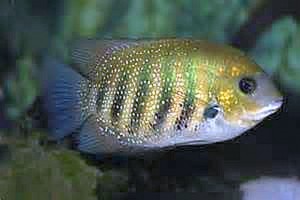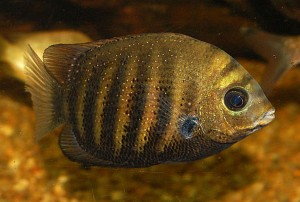The Green Chromide (Etroplus suratensis) is also known by tropical fish keeping enthusiasts as the Pearl Spot, Banded Pearl Spot, Banded Chromide, Banded Etroplus, Karimeen, or Pearlspot Cichlid.
It is native to Sri Lanka and possibly Peninsular India, Peninsular Malaysia and Singapore however, it is believed to have been introduced to India and Malaysia for aquaculture in the early 1950s.
The Green Chromide cichlid inhabits brackish estuaries, coastal lagoons, the lower reaches of rivers and a number of freshwater habitats including a number of inland lakes. It is a hardy species that can breath atmospheric air.
The Green Chromide has a green, greenish brown, or gold tinted oval shaped body with six dark vertical bars on the body (excluding those on the head and caudal peduncle). Gold spots are distributed over the body of the fish, primarily on the upper half.
Compared to other cichlid species, the Green Chromide keeps a “slender” body profile. Although there is no sure visible way to determine the sex of Green Chromides; males that are the same age as females tend to be larger and during breeding, the males develop more intense colors and black occipital stripes between the eye and opercle. Females will develop a reddish, swollen, modified ovipositor during breeding.
The Green Chromide is a relative peaceful species that can be kept in fresh or brackish water aquariums with other Asian cichlids, Archer Fish, or similar sized loaches with the same water parameters. Etroplus suratensis can live in freshwater environments, but they prefer brackish water conditions.
Because of their size, they need a large aquarium of at least 100 gallon capacity with a fine sand or gravel substrate, lots of rock caves and driftwood for them to hide among, and plenty of open swimming space. They are a shoaling species and in an aquarium environment should be housed with at least 8 or more of their own kind to minimize any aggressive behavior. They become aggressive and will eat smaller tank mates when confined in a smaller sized aquarium.
Green Chromides are substrate spawners that may also use caves as spawning sites. Wild fish in Sri Lanka breed twice a year from December to April and again from June to September during the pre monsoon and monsoon seasons. During these periods, water salinity increases and the water becomes cleaner.
In an aquarium environment, because they are sexually mature within a year, it is best to place a group of juvenile Green Chromides together until they pair off. Spawning can be induced by gradually increasing the salinity in the breeding tank to replicate the seasonal monsoons. Put several flat rocks in the aquarium and slowly increase the salinity in the tank to a brackish level. As the water becomes brackish, pairs will begin digging pits to use as nests.
Once the pair select a rock or other site to lay their eggs on, they will defend the surrounding area against all intruders until the eggs are deposited. The female will deposit her eggs on the flat rocks where they are attached to the substrate with short filaments and will hatch, depending on water temperature, within 48 to 72 hours.
After the fry have hatched out, the parents will move the fry for their protection, to the “nursery pits” that they excavated around the spawning site until their egg sacs are absorbed and they become free swimming (in about 3 to 4 days).
During this time, like Discus, the fry remain with the adults and will graze on their parents’ body mucus until they are fully free swimming. The fry can be then be fed newly hatched baby brine shrimp, rotifers, or finely crushed flake food. Both parents stay with the eggs and brood at all times until they are capable of fending for themselves.
Adult Etroplus suratensis are easy to feed and will accept a quality flake and pellet food as a staple diet, along with vegetable matter in the form of lettuce, spinach, peas, Spirulina wafers, and fresh, frozen or freeze dried bloodworms
and brine shrimp.
Minimum Tank Size: 100 gallons
Care Level: Moderate
Temperament: Relatively Peaceful with similar sized fish
Aquarium Hardiness: Moderately Hardy
Water Conditions: 72°F-80°F° F, KH 10-25, pH 7.0-8.0
Max. Size: 16 inches
Color Form: Green, Yellow, Brown
Diet: Carnivorous
Compatibility: OK with Other Asian cichlids or loaches of similar size
Origin: Sri Lanka
Family: Cichlidae
Lifespan: 6-12 years
Aquarist Experience Level: Advanced




